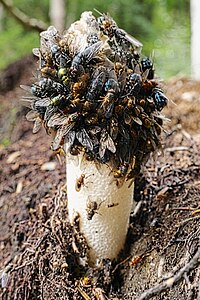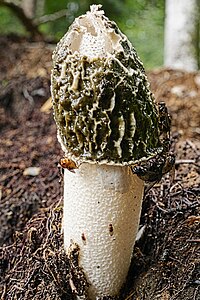Phallus impudicus
| Common stinkhorn | |
|---|---|

| |
| Scientific classification | |
| Domain: | Eukaryota |
| Kingdom: | Fungi |
| Division: | Basidiomycota |
| Class: | Agaricomycetes |
| Order: | Phallales |
| Family: | Phallaceae |
| Genus: | Phallus |
| Species: | P. impudicus
|
| Binomial name | |
| Phallus impudicus L. (1753)
| |
| Synonyms[1] | |
|
Phallus volvatus Batsch (1783) | |
| Phallus impudicus saprotrophic | |
|---|---|
| Edibility is not recommended | |
Phallus impudicus, known colloquially as the common stinkhorn,[2] is a widespread fungus in the Phallaceae (stinkhorn) family. It is recognizable for its foul odor and its phallic shape when mature, the latter feature giving rise to several names in 17th-century England. It is a common mushroom in Europe and North America, where it occurs in habitats rich in wood debris such as forests and mulched gardens. It appears from summer to late autumn. The fruiting structure is tall and white with a slimy, dark olive colored conical head. Known as the gleba, this material contains the spores, and is transported by insects which are attracted by the odor—described as resembling carrion. Despite its foul smell, it is not usually poisonous and immature mushrooms are consumed in parts of France, Germany and the Czech Republic.
Taxonomy
The Italian naturalist
Description
Sometimes called the witch's egg,[6] the immature stinkhorn is whitish or pinkish, egg-shaped, and typically 4 to 6 cm (1.6 to 2.4 in) by 3 to 5 cm (1.2 to 2.0 in).[7]

On the outside is a thick whitish volva, also known as the peridium, covering the olive-colored gelatinous gleba. It is the latter that contains the spores and later stinks and attracts the flies; within this layer is a green layer which will become the 'head' of the expanded fruit body; and inside this is a white structure called the receptaculum (the stalk when expanded), that is hard, but has an airy structure like a sponge.[8] The eggs become fully grown stinkhorns very rapidly, over a day or two.[6] The mature stinkhorn is 10 to 30 cm (3.9 to 11.8 in) tall and 4 to 5 cm (1.6 to 2.0 in) in diameter,[7] topped with a conical cap 2 to 4 cm (0.8 to 1.6 in) high that is covered with the greenish-brown slimy gleba. In older fungi the slime is eventually removed, exposing a bare yellowish pitted and ridged (reticulate) surface. This has a passing resemblance to the common morel (Morchella esculenta), for which it is sometimes mistaken.[9] The rate of growth of Phallus impudicus has been measured at 10–15 cm (4–6 in) per hour. The growing fruit body is able to exert up to 1.33 kPa of pressure — a force sufficient to push up through asphalt.[10] The spores have an elliptical to oblong shape, with dimensions of 3–5 to 1.5–2.5 µm.[9]
Similar species
In North America, Phallus impudicus can be distinguished from the very similar P. hadriani by the latter's purplish-tinted volva.[11] Other similar species include Clathrus ruber, Lysurus cruciatus, and Lysurus mokusin.[11]
Spore dispersal
The dispersal of spores is different from most "typical" mushrooms that spread their
- Stinkhorn
-
Cap covered by insects.
-
Same specimen not covered by insects.
There is also a possible ecological association between the P. impudicus and badger (Meles meles) setts.[17] Fruiting bodies are commonly clustered in a zone 24 to 39 metres (79 to 128 ft) from the entrances;[18] the setts typically harbor a regularly-available supply of badger cadavers – the mortality rate of cubs is high, and death is more likely to occur within the sett.[19] The fruiting of large numbers of stinkhorns attracts a high population of blow-flies (Calliphora and Lucilla breed on carrion);[20] this ensures the rapid elimination of badger carcasses, removing a potential source of disease to the badger colony. The laxative effect of the gleba reduces the distance from the fruiting body to where the spores are deposited, ensuring the continued production of high densities of stinkhorns.[18]
Distribution and habitat
The common stinkhorn can be found throughout much of
Uses
Edibility
At the egg stage, pieces of the inner layer (the receptaculum) can be cut out with a knife and eaten raw.[30] They are crisp and crunchy with an attractive radishy taste.[31] The fungus is enjoyed and eaten in France and parts of Germany, where it may be sold fresh or pickled and used in sausages.[8] Similar species are consumed in China.
Medicinal properties
Venous thrombosis, the formation of a blood clot in a vein, is a common cause of death in breast cancer patients; patients with recurrent disease are typically maintained on anticoagulants for their lifetimes. A research study has suggested that extracts from P. impudicus can reduce the risk of this condition by reducing the incidence of platelet aggregation, and may have potential as a supportive preventive nutrition.[32] It was used in medieval times as a cure for gout and as a love potion.[8]
Folk uses
In Northern
In 1777, the reverend John Lightfoot wrote that the people of Thuringia called the unopened stinkhorns "ghost's or daemon's eggs" and dried and powdered them before mixing them in spirits as an aphrodisiac.[33]
In culture
Writing about life in Victorian Cambridge, Gwen Raverat (granddaughter of Charles Darwin) describes the 'sport' of stinkhorn hunting:
In our native woods there grows a kind of toadstool, called in the vernacular The Stinkhorn, though in Latin it bears a grosser name. The name is justified, for the fungus can be hunted by the scent alone; and this was Aunt Etty's great invention. Armed with a basket and a pointed stick, and wearing special hunting cloak and gloves, she would sniff her way round the wood, pausing here and there, her nostrils twitching, when she caught a whiff of her prey; then at last, with a deadly pounce, she would fall upon her victim, and poke his putrid carcass into her basket. At the end of the day's sport, the catch was brought back and burnt in the deepest secrecy on the drawing-room fire, with the door locked; because of the morals of the maids.[34]
In Thomas Mann's novel The Magic Mountain (Der Zauberberg), the psychologist Dr. Krokowski gives a lecture on the Phallus impudicus:
And Dr. Krokowski had spoken about one fungus, famous since classical antiquity for its form and the powers ascribed to it -- a morel, its Latin name ending in the adjective impudicus, its form reminiscent of love, and its odor, of death. For the stench given off by the impudicus was strikingly like that of a decaying corpse, the odor coming from greenish, viscous slime that carried its spores and dripped from the bell-shaped cap. And even today, among the uneducated, this morel was thought to be an aphrodisiac.[35]
In Danilo Kiš's novel Garden, Ashes the protagonist's father Eduard Schaum provokes the suspicions of the local residents and authorities through his mad wandering and sermonizing in the forests:
The story went round, and was preached from the pulpit, that his iron-tipped cane possessed magical powers, that trees withered like grass whenever he walked in the Count's forest, that his spit produced poisonous mushrooms --Ithyphalus impudicus--that grew under the guise of edible, cultivated varieties. [36]
References
- ^ "Phallus impudicus L. 1753". MycoBank. International Mycological Association. Retrieved 2011-06-17.
- ^ "Standardized Common Names for Wild Species in Canada". National General Status Working Group. 2020.
- ISBN 0-7167-2600-9.
- ^ Linnaeus C. (1753). Species Plantarum (in Latin). Vol. 2. Stockholm, Sweden: Impensis Laurentii Salvii. p. 1178.
- ISBN 0-304-52257-0.
- ^ ISBN 0-14-063005-8.
- ^ ISBN 0-412-36970-2.
- ^ ISBN 0-584-10324-7.
- ^ ISBN 0-89815-169-4.
- ^ .
- ^ ISBN 978-0520271081.
- S2CID 26205424.
- .
- S2CID 28235413.
- ISBN 0-88192-586-1.
- S2CID 11321067.
- ^ Sleeman, D.P.; Cronin, J.N; Jones, P. (1995). "Initial observations on stinkhorn fungi at badger setts". Irish Naturalists' Journal. 26: 76–77.
- ^ .
- ISBN 0-85661-082-8.
- ^ Hancox, M. (1991). "The insect fauna and decomposition of badger carrion". Amateur Entomology Society Bulletin. 50: 255–57.
- ^ Bau, Y-S; Liu B. (1984). "Phalloides of China". Life Sciences Advances. 3 (1): 50–55.
- ^ Hosaka, K. (2010). "Preliminary list of Phallales (Phallomycetidae, Basidiomycota) in Taiwan". Memoirs of the National Museum of Nature and Science (46): 57–64.
- ^ Khare, B. (1976). "Some Gasteromycetes from Uttar Pradesh India". Indian Phytopahtology. 29 (1): 34–38.
- ^ Saenz, J.A.; Nassar, M. (1982). "Mushrooms of Costa Rica – families Phallaceae and Clathraceae". Revista de Biología Tropical. 30 (1): 41–52.
- ^ Hallgrimsson, H.; Jensson, E.; Kristinsson, H. (1992). "Three new Gasteromycetes discovered in Iceland". Náttúrufræðingurinn (in Icelandic). 61 (3–4): 219–27.
- .
- ISBN 0-643-06907-0.
- ISBN 0-85613-056-7.
- ^ Andersson, O. (1989). "The distribution and ecology of Phallus impudicus in the Nordic countries". Svensk Botanisk Tidskrift. 83 (4): 219–41.
- ISBN 0-340-39935-X. The entry for P. impudicus in this book explains the structure and mentions the edibility of the inner layer.
- ISBN 0-674-44555-4.
- .
- ^ Lightfoot, John. Flora Scotica: or, a systematic arrangement, in the Linnaean method, of the native plants of Scotland and the Hebrides. Vol. 2. London: B. White. pp. 1046–47.
- ISBN 0-571-06742-5.
- ISBN 0-679-44183-2.
- ISBN 1-56478-326-X.
External links
 Media related to Phallus impudicus at Wikimedia Commons
Media related to Phallus impudicus at Wikimedia Commons


